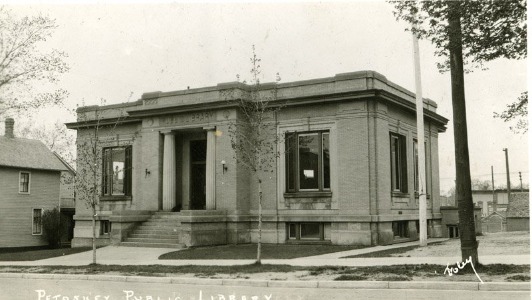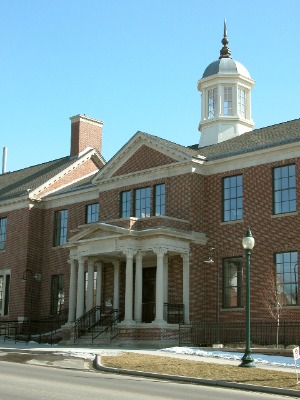.png)
Early Carnegie History
(written by Jeanne Fought)
1901
Throughout October of 1901, Petoskey was abuzz with the news that Mr. Andrew Carnegie would give fifteen thousand dollars for the construction of a building suitable for a public library if the city agreed to tax itself $1,500 a year and provide a “suitable site.” This began the uninterrupted involvement of the City of Petoskey with a public library. A public library was considered so important to the welfare of city residents that a public library was mandated in the City Charter of 1924 and again supported in the 1984 Charter revision.
The idea of having a free library was not a new one. For years, one goal of the Petoskey Literary Society was the creation of a library. The Society held its first meeting on February 11, 1876. This became a reality when in 1884, the Ladies Library Association acquired a room in the Snyder block for one year, for rent-free library purposes. The Snyder block is now the Gattle's building on the corner of Lake and Howard Streets.
1905
The Petoskey Public Library was established by the Common Council of the City of Petoskey in October 1905, and on November 1, a library commission was appointed. Through cooperation with the public schools and citizen donations, the commission was able to establish “a fully equipped and cataloged library of about 2000 volumes” on the second floor of the First National Bank building (currently Chase Bank) in June 1906.

Throughout the first year, there was a constant increase in patronage and it was only a matter of time before the rooms were taxed to their limit. A Carnegie Library was within reach. The commission was informed that they could draw on Carnegie's funds to the amount of $12,500, provided the city would furnish a site and maintain the library when completed.
It is interesting to note that on January 31, 1906, the Petoskey Record reported “Yesterday 1,200 volumes for the district library were removed from the high school building. The Board feels deeply grateful for the help given them by the Ladies Library Association, who turned over $200 for their use; to Mr. Chalmers Curtis, who gave electric light fixtures and $10 in money; and to the Bachelor girls, who gave the $26 cleared at their holiday dance. The Board elected Mrs. Faulkner librarian, at a salary of $3 per week, and the rooms will be open for the present Tuesday, Thursday, and Saturday afternoons and evenings.” Funding was always precarious and we have this from the proceedings of February 20, 1906: “Resolved, that the city clerk and mayor draw a warrant on the city depository for the sum of $83.75, transferring from the dog fund to the library fund and that it be made available at once. Adopted.”
1908
Mrs. Lelia Johnson purchased the present site in memory of her husband and presented it to the city. The warranty deed, dated January 11, 1908, states: “This conveyance is made to furnish the people of the City of Petoskey, a site for a free public library and under the express condition that it is to be forever as a free public library and for no other purpose.”
On January 27, 1908, Andrew Carnegie gave the City of Petoskey $12,500, and the Common Council agreed by resolution to maintain the library when completed. An additional $5,000 was raised through taxation so that a better building could be erected.
The existing Carnegie Library building is one of the most significant historic buildings in Petoskey, architecturally as the most outstanding example of the neo-classical revival style, and historically as one of an ever-decreasing number of remaining Carnegie libraries in the country. It is listed on the National Register of Historic Places by its inclusion in the Downtown Petoskey Historic District. It is the oldest municipal building in Emmet County in continuous original use.
The Grand Rapids firm of Williamson & Crow, Architects designed the building constructed in 1908 and dedicated in 1909. Only the best stone and brick were to be used on the exterior, with black ash woodwork used extensively inside. A fireplace, pictures, plants, and suitable furniture were all added to enhance its beauty and cultural atmosphere. In the basement, a large handsomely equipped assembly room that sat 125, was created for meetings of an “educational and patriotic nature.”
According to an article in the Grand Rapids Herald of February 4, 1923, the Petoskey Public Library was ranked among the best in the State of Michigan. Petoskey had the best circulation of any library in Michigan.
Later Carnegie and the Expansion Project
1989
Changes to the building over the years include new glass doors at the main entrance; the enlarging of the librarian's office on the east side of the building; and the stairs to the side entrance to the auditorium being enlarged and improved. These were removed in 1989 for the addition of a new entrance stair and elevator linking it with the then McCune Arts Center next door, thus finally making the library easily accessible by everyone.
Also in 1989, the City of Petoskey purchased the former Michigan Bell Telephone Company building across Mitchell Street from the Carnegie Library, on the recommendation of the Library Commission, for library expansion. It was not until 2000 that the Friends of the Petoskey Public Library spearheaded a successful millage drive to fund the proposed expansion, operation, and restoration of the Carnegie building.
2004
The new Library opened in November 2004. In 2007, the Library celebrated 100 years since its inception, and in 2008, the 100th anniversary of the Carnegie Building.

2009
On August 3, 2009, the City of Petoskey created the Petoskey District Library, which was approved by the State Librarian on September 17, 2009. The area of the district includes the city limits of the City of Petoskey.
Bear Creek and Resort Townships passed operating millages of .4 mill for four years on August 7, 2012. And then on November 8, 2016, the voters of Little Traverse and Springvale Townships passed a ballot initiative in support of contracting library services with Petoskey at a rate of 0.40 mills, and Bear Creek and Resort Townships renewed operating millages of .4 mill for another four years.

 Log In
Log In